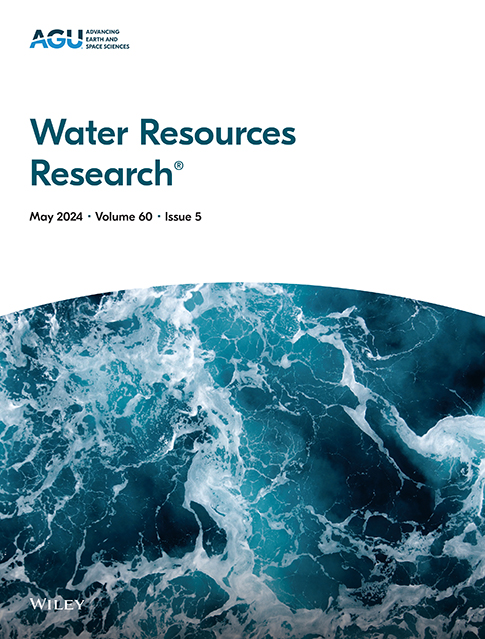季节性控制氧、碳和氮在12米、54小时长的潜流路径上的生物地球化学变化
IF 4.6
1区 地球科学
Q2 ENVIRONMENTAL SCIENCES
引用次数: 0
摘要
潜流交换对河流走廊生物地球化学至关重要,但由于后勤方面的挑战(例如,深度采样,多日运输时间),对十米尺度的流动路径(~ 10米长)的研究不足。一些研究表明,十米尺度的流道应该具有初始热点,然后是运输限制条件,而另一些研究则认为,稳定的反应速率和二次反应可能使十米尺度的流道变得重要而独特。我们沿着一条12米深的暗中游环境研究了生物地球化学,该中游环境允许沿着固定几何形状和恒定流量的流动路径进行季节性和空间水质变化的控制测试。在多个季节中沿中尺度以1 m间隔测量了氧、碳和氮的水质剖面。中生态前6 m始终是流动孔隙水的氧源和净氮源。在冬季,氧条件持续到12 m,而流道的后半部分在夏季变为缺氧和净氮汇。在中观的第一米未观察到反应热点。相反,大多数反应在12米和54小时的传递时间内都是零级反应。由于与河流衍生的反应物源相比,有大量的原位反应物源,因此,进水化学对隐性生物地球化学的影响比预期的要小。吸附或掩埋的碳可能会促进反应,其速率由温度和氧化还原条件控制。每种反应物都表现出不同的次循环Damköhler数,这对固有的反应或运输受限的流动路径的表征提出了挑战。未来的研究应探讨十米尺度流道在不同野外环境下的普遍性和生物地球化学贡献。本文章由计算机程序翻译,如有差异,请以英文原文为准。
Seasonality Controls Biogeochemical Shifts in Oxygen, Carbon, and Nitrogen Along a 12-m, 54 hr-Long Hyporheic Flowpath
Hyporheic exchange is critical to river corridor biogeochemistry, but decameter-scale flowpaths (∼10-m long) are understudied due to logistical challenges (e.g., sampling at depth, multi-day transit times). Some studies suggest that decameter-scale flowpaths should have initial hot spots followed by transport-limited conditions, whereas others suggest steady reaction rates and secondary reactions that could make decameter-scale flowpaths important and unique. We investigated biogeochemistry along a 12-m hyporheic mesocosm that allowed for controlled testing of seasonal and spatial water quality changes along a flowpath with fixed geometry and constant flow rate. Water quality profiles of oxygen, carbon, and nitrogen were measured at 1-m intervals along the mesocosm over multiple seasons. The first 6 m of the mesocosm were always oxic and a net nitrogen source to mobile porewater. In winter, oxic conditions persisted to 12 m, whereas the second half of the flowpath became anoxic and a net nitrogen sink in summer. No reactive hot spots were observed in the first meter of the mesocosm. Instead, most reactions were zeroth-order over 12 m and 54 hr of transit time. Influent chemistry had less impact on hyporheic biogeochemistry than expected due to large amounts of in situ reactant sources compared to stream-derived reactant sources. Sorbed or buried carbon likely fueled reactions with rates controlled by temperature and redox conditions. Each reactant showed different hyporheic Damköhler numbers, challenging the characterization of flowpaths being intrinsically reaction- or transport-limited. Future research should explore the prevalence and biogeochemical contributions of decameter-scale flowpaths in diverse field settings.
求助全文
通过发布文献求助,成功后即可免费获取论文全文。
去求助
来源期刊

Water Resources Research
环境科学-湖沼学
CiteScore
8.80
自引率
13.00%
发文量
599
审稿时长
3.5 months
期刊介绍:
Water Resources Research (WRR) is an interdisciplinary journal that focuses on hydrology and water resources. It publishes original research in the natural and social sciences of water. It emphasizes the role of water in the Earth system, including physical, chemical, biological, and ecological processes in water resources research and management, including social, policy, and public health implications. It encompasses observational, experimental, theoretical, analytical, numerical, and data-driven approaches that advance the science of water and its management. Submissions are evaluated for their novelty, accuracy, significance, and broader implications of the findings.
 求助内容:
求助内容: 应助结果提醒方式:
应助结果提醒方式:


